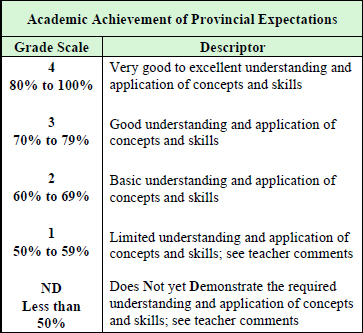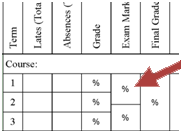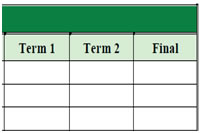Assessment and Evaluation
Frequently Asked Questions: Assessment and Grading
The following FAQs address the interpretation and application of policies and guidelines found in the document Manitoba Provincial Report Card Policy and Guidelines.
Determining a Mark
For grades 7 and 8, are the categories all weighted the same, or differently? If differently, how?
A student’s overall grade should reflect the emphasis of instruction and, therefore, assessment and resulting assessment evidence, which may vary over the course of a school year. It is not intended or recommended that numeric weights be applied to subject category grades to arrive at overall grades; rather, the overall grade is determined by pooling the evidence of learning (teacher professional judgement is used to determine which evidence to use for grading). See section 4.3 of the report card policy and support document for more information.
Can the report card grade scale descriptions be used as a daily classroom assessment rubric?

The grade scale is a communication tool for parents, and so not designed for daily use as a scoring rubric. It should, however, guide in the development and interpretation of rubrics used in assessing daily student work (projects, assignments, tests, etc.) to ensure that marks and ratings for classroom tasks are interpretable for determining report card grades.
Scorings rubrics are valuable tools for communicating about performance criteria, particularly when co-created with students, and for guiding scoring. Rubrics generally include descriptions or criteria specific to the task and learning outcomes. The achievement levels of a rubric will be roughly equally spaced – an ‘interval scale’ – unlike the report card grade scale (an ‘ordinal’ scale) which has a wider Level ‘4’, for example, and no levels near to but below the equivalent of 50%.
Where percentage grades must be reported, evidence of achievement (scores, marks, rubric ratings, etc.) should be expressed using scales that can be converted to percentage grades.
See the section Assigning Grades in the Policy and Guidelines document for more information.
Exam Mark
In the non-semestered report card (Grades 9–12), every subject has two cells for marks in the Exam Mark column. Why? Where does the mark for the final exam go?

The cell indicated by the arrow could contain
- the mark for an exam taken at the end of Term 1,
- the mark for an exam taken at the end of Term 2, or
- the code NE to indicate that there was no exam, or ‘NM’ if there was an exam but the student was exempted or excused.
The cell below it is for the Final Exam.
It is possible for all the cells under Exam Mark to have ‘NE’ if the school has no comprehensive midterm or final exams.
If a student is exempted from a school-based final exam because he or she met a minimum mark requirement, how should this be reported?
Use ‘NM’. A comment should be provided to explain.
Final Grade
What does the focus on ‘most recent and consistent learning’ look like in practice?
The section Assigning Grades in Policy and Guidelines states:
Grades that students receive in a particular term reflect a student’s achievement as demonstrated from the beginning of the course, determined according to the foundational principles for grading (see section 1.2). Greater consideration should be given to learning demonstrated later in the course, as appropriate for the nature of the particular course and teaching approach. At the senior years, the same principle applies for the term grades. Therefore, the Final Grade is the same as the last term grade unless there is a final exam.
The achievement grade on a report card represents the student’s achievement with respect to curricular learning goals addressed up to the end of the reporting period with a focus on the student’scurrent standing with respect to those goals.
When a learning trajectory involves integrating and revisiting outcomes to achieve and consolidate learning goals over the course of a school year, the student’s most recent and consistent performance with respect to those goals is used to determine grades. Low marks from evidence of learning recorded earlier in the school year would not be applied to determining grades if subsequent evidence of learning for that goal shows improvement.
Learning goals addressed to completion in an earlier term, and not addressed again, continue to be reflected in the student’s report card grades for later terms and in the final grade.
Does the achievement grade entered for Term 2 reflect the second term only?

No. The Term 2 grade includes consideration of evidence of learning up to the end of Term 2. The section Reporting Frequency, Responsibility, and Content of the Policy and Guidelines document states as policy:
The term report cards will communicate a student’s achievement relative to content completed up to that point in time, along with comments from teachers.
See the response to item above, regarding how to approach ‘consideration of evidence’.
Can high marks be given on an interim report card even though end-of-year curricular learning outcomes have not yet been achieved?
Yes. A grade of ‘4’ or, where percentage grades apply, of over 80% reflecting ‘very good to excellent’ achievement is possible at any point in the school year. The section Assigning Grades in Policy and Guidelines states:
Academic achievement grades are based on the student’s achievement with respect to learning goals addressed in class in the term or terms leading up to the current term’s report card. Therefore, it is possible for a student to receive a grade of ‘4’, for example, or a percentage grade above 80%, in the first term.
In term and final report cards, is it possible that a student can have declining grades,
such as 4 – 4 – 3?
Yes. A student might perform very well relative to interim learning goals, but then not as well relative to curriculum-based end-of-year learning goals.
Is the report card issued in the first term essentially an assessment based on outcomes from the previous grade?1
No. Interim learning goals set by the teacher towards achieving end-of-grade learning goals are the basis of assessment and grading. However, it is normal that differentiation and scaffolding will include, as needed, reminders of knowledge and skills from the previous grade.
Is it possible for many students in my class to achieve a grade of ‘4’?
Yes. An achievement grade of ‘4’ reflects grade-level learning goals. It applies when a student exhibits fluency and accuracy in their application of knowledge and skills and, in addition, articulates their thinking and critically evaluates their strategies and products.
Level 4 represents a range of performance applicable as well to students who exhibit these attributes even if not at all times and under all conditions.
Does a grade of ‘4’ indicate that a student is achieving beyond grade-level outcomes?
No. A student at Grade 4, for example, is assessed based on Grade 4 curricula, not curricula from another grade, e.g., Grade 5 (unless there is an individual education plan). Therefore, an achievement grade of ‘4’ does not equate to meeting Grade 5 outcomes, to continue the example. Student programming targeting outcomes from a grade other than the student’s classroom grade would be documented in an IEP.
Does a grade of ‘ND’ indicate that a student is achieving below grade-level outcomes?
No. ‘ND’ (Not Demonstrated) refers to a student’s achievement relative to grade-level interim learning targets or end-of-year outcomes.
1Note that the report card differs from the provincial Grade 3/4 Assessment in this regard.
Is it appropriate to use the bell curve for grading?
No. Distributing students’ grades ‘on a curve’ is inappropriate in school assessment and evaluation. The section Foundational Principles for Grading in Policy and Guidelines document states:
Students’ grades are based on teachers’ professional judgement of gathered evidence relative to grade-level curriculum-based learning goals (not on factors such as attendance, punctuality, attitude, effort and behaviour).
There is no consideration given to the performance of other students when determining a student’s report card grade. In addition, group/class marks are not valid for determining a student’s achievement grade.
What is the expectation for weighting the subject categories when determining report card overall grades (applies to Grades 7 and 8, only)?
The quantity of achievement evidence (scores, marks, etc.) recorded and used for report card grade determination will reflect the degree of emphasis on the knowledge and skills associated with each subject category up to the end of the reporting period. When this evidence is pooled, the overall achievement grade will be naturally balanced relative to classroom emphasis on the categories. Pre-assigning weights to be applied programmatically, such as within a gradebook program, is not expected, recommended or desirable from the perspective of principles of teaching and assessment.
See the section Assigning Grades in the Policy and Guidelines document.
How do I convert from the ordinal (ND, 1,2,3,4) scale to percentage grades (applies to Grades 7 and 8 in particular)?
Grades on the ordinal scale cannot be converted to percentage grades since each level of the scale is associated with a range of percentage grades. For example, a `4` is not equivalent to 4/4 or 100%, and a ‘3’ is not equivalent to 3/4, etc. In particular, a ‘1’ on the report card grade scale is a passing grade (equivalent to 50% to 59%), and not equivalent to ¼.
See the section Assigning Grades in the Policy and Guidelines document for more information and an illustration specific to Grades 7 and 8.
Can the final grade be determined by combining the interim achievement grades?
No, since the Term 2 grade already includes consideration, as appropriate (see item 1), of achievement during the first term. Consistent with this, at high school the final term grade is also the final course grade if there is no final exam reported separately.
Do I report the code ‘ND’ on the report card when there is too little evidence of learning available to determine a grade?
No, not normally. ‘ND’ is used when the evidence indicates that the student ‘is not demonstrating a minimally acceptable level of success to support ongoing learning.’ (See the section Academic Achievement of Policy and Guidelines). ‘IN’ may be used where there is lack of evidence due to extensive absence, for example, at Grades 1 to 6, for the subject categories at Grades 7 and 8, and as interim grade at any grade level. Where percentage grades apply, a Final Grade may not be ‘IN’; rather, in case of lack of evidence, the Final Grade may be left blank. Policy in this regard is provided in the section ‘NA’ – Not Applicable, and ‘IN’ – Incomplete of the Policy and Guidelines document.
A grade of ‘ND’ may result when, as a last resort, marks are deducted for late or missing work and the final grade subsequently determined falls below `1`. See the section Academic Responsibility of Provincial Assessment Policy Kindergarten to Grade 12: Academic Responsibility, Honesty and Promotion/Retention (www.edu.gov.mb.ca/k12/assess/docs/policy_k12/index.html).
IN (Incomplete) and NA (Not applicable)
For Grades 1 to 8, when do we use ‘NA’ and when do we use ‘IN’ for a grade?
‘NA’ indicates that the subject content was not addressed. In the rare cases NA is used, it must be approved by the principal and a comment should explain its use, as described in the report card policy and support document, Section 4.3. ‘IN’ indicates that the subject was addressed, but the student has not yet provided sufficient evidence to evaluate the level of learning. ‘IN’ may also be used when the information concerning evidence of learning is not available to the school. This may occur, for example, if a student has recently transferred to the school and the school does not have sufficient information from the previous school in order to complete the report card.
Can ‘IN’ be used as a Final Grade on the Grades 9 to 12 report card?
Yes, where the department has indicated that it may be used and reported to the department as a final grade.
To indicate that a course is continuing in the next semester, ‘IN’ is indicated as the ‘Grade’ for the final term and a final grade is not given (‘Final Grade’ is left blank). The circumstances must be explained in the comment box. The final grade is reported to the department for the semester or school year in which the student receives the credit.
Provincial Assessments
How do we report on provincial assessments, e.g., the Grades 3/4 and Middle Years Assessments (Mathematics, Reading, Student Engagement, etc.)?
The existing report templates for these provincial assessments are used. The school can send the parent reports for these assessments with the report card or separately.


